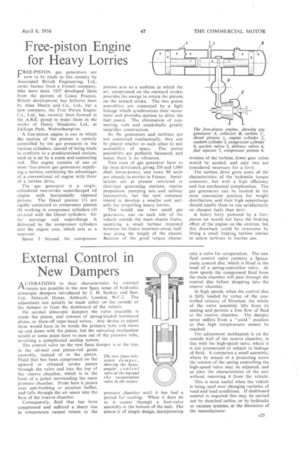Free-piston Engine for Heavy Lorries
Page 27

If you've noticed an error in this article please click here to report it so we can fix it.
E"REE-PISTON gas generators are now to be made in this country by Associated British Engineering, Ltd., under licence from a French company, who have since 1937 developed them from the patents of Count Pescara. British ,development has hitherto been by Alan Muntz and Co., Ltd., but a new company, the Free Piston Engine Co., Ltd., has recently been formed in the A.B.E. group tO make them in the works of Henry Meadows, Ltd., at Fallings Park, Wolverhampton.
A free-piston engine is one in which the motion of the pistons is entirely controlled by the gas pressures in the various cylinders, instead of being made to conform to a predetermined motion, such as is set by a crank and connecting rod. The engine consists of one or more free-piston gas generators supplying a turbine, combining the advantages of a conventional oil engine with those of a turbine drive.
The gas generator is a singlecylindered two-stroke supercharged oil engine with horizontally opposed pistons. The Diesel pistons (1) are rigidly connected to compressor pistons (8) working in compressor cylinders (4) co-axial with the Diesel cylinders. Air for scavenge and supercharge is delivered by the compressor cylinders into the engine case, which acts as a reservoir.
Space 3 beyond, the compressor pistons acts as a cushion in which the air, compressed on the outward stroke, provides the energy to return the pistons • on the inward stroke. The two piston assemblies arc connected by a light linkage which synchronizes their movement and provides motion to drive the fuel pump. The elimination of connecting rods and crankshafts greatly simplifies construction.
As the generators and turbines are not connected mechanically, they can be placed relative to each other to suit availability of space. The piston assemblies are perfectly balanced, and hence there is no vibration.'
Two sizes of gas generator have so far been developed, giving 350 and 1,000 shaft horse-power, and some 80 units are already in service in France. Installations are at present restricted to electrical generating stations, marine propulsion, pumping sets and railway locomotives, but the new company intend to develop a smaller unit suitable for propelling heavy lorries.
This would use two small gas generators. one on each side of the vehicle outside the main chassis frame, supplying a small turbine mounted between the frame members about halfway along the length of the chassis, Because of the good torque charac teristics of the turbine, fewer gear ratios would be needed, and only two are considered necessary for a lorry.
The turbine drive gives some of the characteristics of the hydraulic torque converter, but with a high efficiency and less mechanical complication. The gas generators can be located in the most convenient position for weight distribution, and their high supercharge should enable them to run satisfactorily on cheaper fuels than derv.
A heavy lorry powered by a freepiston set would not have the braking effect of the engine on the overrun, but this drawback could be overcome by fitting a small braking turbine similar to astern turbines in marine use.




















































































